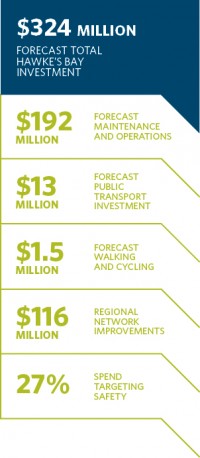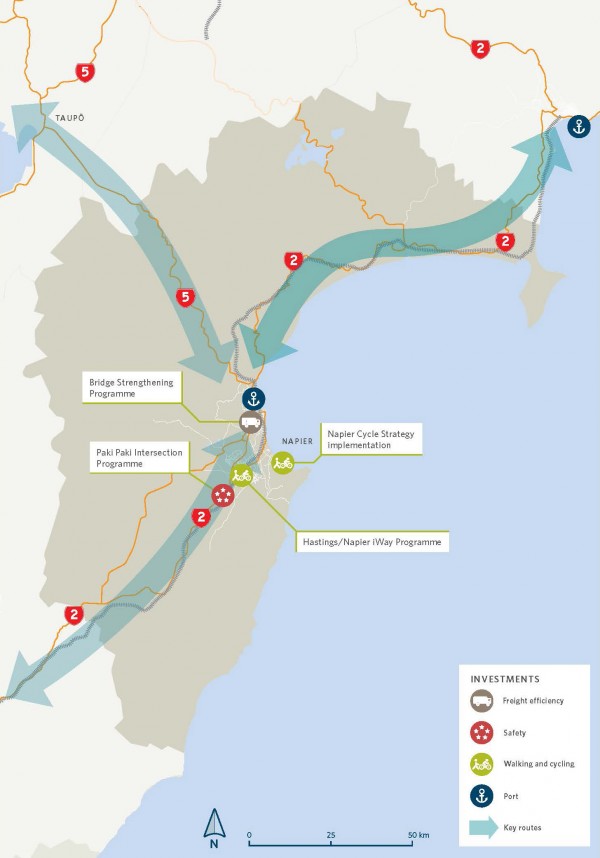
Primary production is the big economic driver for Hawke’s Bay, with investment in the region’s transport system focused on making it safer and easier to get goods to market and to support new tourism opportunities.
Forestry, horticulture and viticulture are the region’s three biggest primary industries, driving the need for efficient and reliable access to ports and processing centres both within Hawke’s Bay and neighbouring regions, and a transport network that can safely support the increase in freight.
This NLTP supports the objectives in the Matariki-Hawke’s Bay Regional Economic Development which include:
A total of $324 million will be invested in the region’s transport network this NLTP.
A large proportion of NLTP funding will be used to maintain the state highways and local roads to ensure safe, reliable journeys throughout the region. This programme of work will include road resurfacing, renewals and general maintenance, and network and asset management.
To ensure best practice and value for money delivery, the NZ Transport Agency will support collaboration among controlling authorities on procurement, management and implementation of maintenance activities.
Hawke’s Bay has more crashes per vehicle kilometre travelled on local roads and state highways than many other regions. There were 18 fatalities on the region’s roads in 2017.
While upgrades to several Hawke’s Bay blackspot intersections are underway, safety remains a significant NLTP focus. Investments focus on reducing risk by addressing unsafe behaviours, and infrastructure and environment improvements for people travelling on the region’s critical links, in particular between Napier Port and Palmerston North.
These projects include improvements to:
Safety promotion programmes around cycling, walking and local roads will be delivered in schools and communities.
Journeys throughout the region are dominated by private vehicles - 90 percent of trips to work in the Napier/Hastings area in 2013 were by car.
While public transport in Napier and Hastings makes up only a small fraction of journeys to work, there are 11 bus routes serving the cities and surrounding communities, providing connections to key destinations like the Hawke’s Bay hospital in Hastings. An express commuter service runs between Napier, Hastings and Havelock North.
The Napier/Hastings area has had significant investment in urban cycling facilities, with more than 108kms of pathways being built during this decade. The iWay project seeks to increase accessibility through the urban areas, and increase the number of local trips being made by bike.
The Hawke’s Bay Regional Council is looking to reduce the environmental impact of the region’s land transport system by supporting the uptake of electric vehicles, and encouraging more people to use public transport and active travel options, such as walking and cycling.
Hawke’s Bay is a popular destination for cyclists. There are about 400,000 annual users of the region’s off-road cycle trails, and more than 200 daily users of the cycle paths between Hastings and Havelock North.
This NLTP supports construction of new cycleways in the iWay cycling programme and a feasibility study for a cycleway north of Napier towards Gisborne.
Public transport is an important service for many people. Local bus services carry about 700,000 passengers annually. With an ageing population, public transport services will need to respond to increased demands and consider the need for new or different bus routes.
Encouraging more people to use buses and active travel options supports wider strategic objectives to reduce the environmental impact of the region’s land transport system.
Reliable and efficient connections are important for Hawke’s Bay regional communities and businesses, as well as tourists.
To help improve travel times and reduce congestion on key routes, NLTP funding has been allocated to continue the Bay View to Hawke's Bay Airport passing lanes. Additional funding is available to investigate programmes of work on SH2 and SH5 including:
Improving access for New Zealanders to economic and social opportunities is one of the key priorities in the Government Policy Statement on land transport. Projects to include access within the region include:
